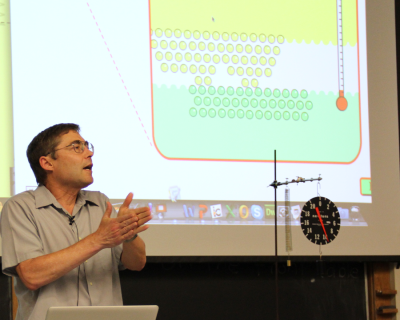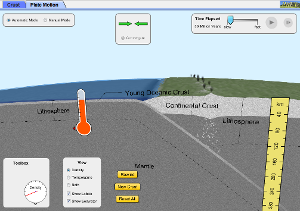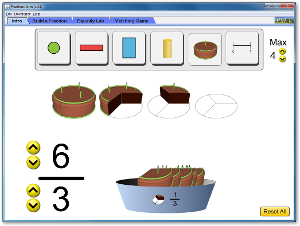|
||||||||||||||||||||||
|
||||||||||||||||||||||
|
Help keep PhET free! Individual donations bring science to kids in your town and around the world. So please consider:
All donations are tax deductible. Thanks for your support! In the Pipeline:
Upcoming Events:Virtual School Symposium
American Chemical Society NSTA National Council of Teachers of
Mathematics Stay Connected:
Join us on Feedback or Suggestions?If you have any ideas, please let us know at phethelp@colorado.edu. |
Meet Our Founder and Nobel Laureate, Carl Wieman:
In your opinion, what makes PhET sims special? Using the sims as a teacher, which I've done a lot myself, one thing that makes them special is that they get the students really engaged. The students follow the sims, they're interested in it, they want to explore with it. But it also brings in real-world experiences and connects up what they know from the outside world with the kind of book-learning we're trying to achieve. I think that it's very important in science not just to produce more scientists, although that's clearly important, but also to allow everybody to understand science better and to understand the role it plays in our lives. The sims bridge this gap in a way no other educational materials can. They strip out a lot of the technical jargon and the mathematics and therefore make the basic science much more accessible and understandable. The students develop their own mental models of physical phenomena. That's a much deeper, more useful level of understanding than memorizing procedures and facts, which is a lot of what people get in classes, but is really not real expertise in the subject. Another very nice feature is they really invite students to engage in scientific thinking themselves. By interacting with the sims, the students test things, make predictions, develop models so they see what science really is all about. With the sims, the invisible becomes visible, and they can see what atoms and light are doing. This process of discovering really helps them identify as scientists. They can see how "I can discover things and understand things." Suddenly, larger groups of people who would never have experienced this before (including in particular groups very underrepresented in science) can start thinking of themselves, essentially, as potential scientists.So what makes the sims so effective in reaching students? There's all kind of efforts to bring technology into education. But, what we've strived for, and I think what makes PhET unique, is the fact that it's based on looking very carefully at what we know about learning, how the human brain learns, and builds into the technology the activities that achieve that. That's done by having very good software engineers work with excellent scientists who know the materials and educational researchers who understand how people learn. They do a very careful iterative process of testing how effectively these work, refining them, changing them, and improving them until we have something that we can really be quite confident achieves the desired interaction and learning. I think if you look at the most educational technology, it really has not gone through this sort of developmental process, and it's not building on research on learning.Where do you think PhET can improve? PhET has made great strides, but I see there's still a great deal to be done, and a great many future opportunities. Every time I turn around I notice something, whether it's biology or paleontology, where I think, "Gee, a PhET simulation would really help teach this!" And of course that applies down into grade school and up into graduate school. So there are enormous opportunities. But one of the things we need to work on is more research showing their effectiveness. The research so far has been really dominated by our own group, and I think there are tremendous opportunities to do more research on understanding both how to optimize what students are learning and how they're best learning from PhET sims. From that work, we can really understand how to use educational technology in more effective ways than people are doing right now. Also, another area where I see we need to improve is providing more support and guidance to teachers on how to use these powerful simulations in the most educationally effective ways. Because this is a new technology, teachers are not familiar with them. We need to support them with more professional development so they can take full advantage of the capability and power of an interactive simulation for education.Reflecting on the past 10 years, has the project met your hopes and expectations? When I first started PhET, I didn't really have nearly the grand vision it's turned into. I just saw lots of opportunities to use the sims in classes I was teaching and other people were teaching. I thought, "This would make it a lot easier to understand material and make it a lot more interesting. Simulations could do a better job of showing students how physics relates to the real world around them." And it was only as we developed more and more sims and we saw the use growing throughout the world that I began to see the broader potential for PhET impacting education. What really surprised me was the international span of it, how they are being translated into so many languages and being used by many tens of millions of students all across the world.What are some of the challenges facing PhET? One of the ongoing challenges for the PhET project is that it's expensive to develop such a high-quality product and keep it continually upgraded and up to date. For example, technology is changing all the time. There are new platforms, new hardware, new software. That puts great demands on a project like PhET to keep at the cutting edge, to keep upgrading, to keep branching out so it can be used on tablets or the next thing that's going to come after that. That's just part of the price of working with technology that one has to do, but it has a significant price that one has to face. We're hoping that people will see how they can help support PhET as we did, to build it to enhance science education.
Help bring PhET simulations to the iPad! Featured New Sims:Plate Tectonics
Fractions Intro
Check Out These Other New Simuations:Don't forget to join us on Facebook, Twitter and our Blog!Be the first to learn about new sims, new teacher activities, articles and newsletters. We'd also love to hear how you use PhET in your classrooms. Spread the word so PhET can go viral.... |
|||||||||||||||||||||
|
You received this e-mail because you signed up at our website or emailed us at phethelp@colorado.edu. To opt out of these newsletters, please click on this link: @UNSUBSCRIBE@ or copy and paste the text into your browser. PhET Interactive Simulations | University of Colorado 390 UCB | Boulder, CO 80309-0390 |
||||||||||||||||||||||








